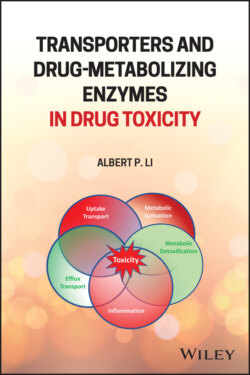Читать книгу Transporters and Drug-Metabolizing Enzymes in Drug Toxicity - Albert P. Li - Страница 2
Table of Contents
Оглавление1 Cover
2 Title Page
3 Copyright Page
4 Preface
5 List of Contributors
6 Part I: Overview 1 Overview 1.1 Drug Toxicity as a Challenge in Drug Development 1.2 Fate of an Orally Administered Drug 1.3 The Multiple Determinant Hypothesis for Idiosyncratic Drug Toxicity 1.4 Concluding Remarks References 2 Transporter, Drug Metabolism, and Drug‐Induced Liver Injury in Marketed Drugs 2.1 Introduction 2.2 Hepatic Metabolism 2.3 Reactive Metabolite Formation and Assessment 2.4 Hepatic Transporters 2.5 Genetic Variants and Their Impact for Pharmacokinetic Behavior and Safety 2.6 Summary Acknowledgment Disclaimer References 3 Drug‐Metabolism Enzymes and Transporter Activities as Risk Factors of Selected Marketed Drugs Associated with Drug‐Induced Fatalities 3.1 Introduction 3.2 Acetaminophen 3.3 Cerivastatin 3.4 Felbamate 3.5 Flucloxacillin 3.6 Nefazodone 3.7 Obeticholic Acid 3.8 Sitaxentan 3.9 Sorivudine 3.10 Tacrine 3.11 Terfenadine 3.12 Troglitazone (Rezulin®) 3.13 Trovafloxacin 3.14 Conclusions References
7 Part II: Drug Metabolizing Enzymes and Drug Toxicity 4 Drug‐Metabolizing Enzymes and Drug Toxicity 4.1 Introduction 4.2 Drug‐Metabolism Enzymes Involved in Metabolic Activation and Detoxification 4.3 Cytochrome P450 Monooxygenase (CYP) 4.4 Non‐P450 Drug‐Metabolizing Enzymes 4.5 Conclusions References 5 Genetic Polymorphism of Drug‐Metabolizing Enzymes and Drug Transporters in Drug Toxicity 5.1 Introduction 5.2 Drug‐Induced Liver Injury 5.3 Drug‐Induced Skin Injury and Related Hypersensitivity Reactions 5.4 Statin‐Induced Myopathy 5.5 Conclusions References 6 Acyl Glucuronidation and Acyl‐CoA Formation Mechanisms Mediating the Bioactivation and Potential Toxicity of Carboxylic Acid‐containing Drugs 6.1 Introduction 6.2 Phase II Metabolism 6.3 Chemical Stability of Phase II Metabolites 6.4 Phase II Metabolite Chemical Reactivity 6.5 Phase II Metabolite‐Mediated Covalent Binding 6.6 Phase II Metabolite Prediction of Covalent Binding 6.7 Studies Directly Comparing Carboxylic Acid Drug Bioactivation by Acyl Glucuronidation and Acyl‐CoA Formation 6.8 Prediction of Drug‐Induced Liver Injury for Carboxylic Acid Drugs 6.9 Conclusions References 7 Liquid Chromatography‐Mass Spectrometry (LC‐MS) Quantification of Reactive Metabolites 7.1 Introduction 7.2 LC‐MS Methods Using GSH as a Trapping Reagent 7.3 Using Other Trapping Reagents 7.4 Identification and Characterization of Rearranged GSH Adducts 7.5 Strategies for Optimization and Decision Tree 7.6 Summary Acknowledgment References 8 Human‐Based In Vitro Experimental Approaches for the Evaluation of Metabolism‐Dependent Drug Toxicity 8.1 Introduction 8.2 Assays for Reactive Metabolites 8.3 Cell‐Based Assays for Metabolism‐Dependent Toxicity 8.4 Primary Human Hepatocyte Assays for Metabolism‐Dependent Drug Toxicity 8.5 Emerging Hepatocyte Technologies for the Evaluation of Drug Toxicity 8.6 Integrated Discrete Multiple Organ Coculture (IdMOC®) 8.7 Conclusion References
8 Part III: Drug Transporters and Drug Toxicity 9 Mechanism‐Based Experimental Models for the Evaluation of BSEP Inhibition and DILI 9.1 Introduction 9.2 Membrane Vesicles to Study BSEP Inhibition 9.3 Sandwich‐Cultured Hepatocytes to Study BSEP Inhibition 9.4 Other In Vitro Methods to Study BSEP Inhibition 9.5 Computational Methods Used to Predict BSEP Inhibition 9.6 In Vitro Models as a Predictor of Clinical DILI 9.7 Preclinical In Vivo Models for the Evaluation of BSEP Inhibition and DILI 9.8 In Vivo Clinical Biomarkers of BSEP Inhibition and DILI 9.9 Quantitative Systems Toxicology to Predict DILI 9.10 Conclusions Funding Information Conflict of Interest Acknowledgments References 10 Hepatic Bile Acid Transporters in Drug‐Induced Cholestasis 10.1 Introduction 10.2 Bile Acid and DIC 10.3 Hepatic Bile Acid Uptake Transporters in DIC 10.4 Hepatic Bile Acid Efflux Transporters in DIC 10.5 Bidirectional Bile Acid Transporter OSTα/β 10.6 Summary References 11 Role of Renal Transporters in Drug–Drug Interactions and Nephrotoxicity 11.1 Overview of Renal Transporters 11.2 Renal Transporters and Drug–Drug Interactions 11.3 Renal Transporters and Nephrotoxicity 11.4 Biomarkers and Nephrotoxicity 11.5 Conclusion References 12 Blood–Brain Barrier Transporters and Central Nervous System Drug Response and Toxicity 12.1 Over‐View of the Brain Barriers 12.2 General Influence of BBB Transporters on Drug Entry into the Brain 12.3 BBB‐Transporter Effects on CNS Drug Response 12.4 Transporter Considerations Influencing CNS Drug Response 12.5 Conclusions References 13 Ototoxicity and Drug Transport in the Cochlea 13.1 Auditory System Anatomy 13.2 Auditory System Physiology 13.3 Hearing Loss, Ototoxic Drugs, and Hair Cell Damage 13.4 Drug Metabolism in the Ear 13.5 Conclusion References
9 Part IV: Modeling Drug Metabolizing Enzymes‐Transporters Interplay for The Prediction of Drug Toxicity 14 Application of a PBPK Model Incorporating the Interplay Between Transporters and Drug‐Metabolizing Enzymes for the Precise Prediction of Drug Toxicity 14.1 Importance of the Consideration of Intracellular Concentration of Drugs in the Tissue for Estimation of Pharmacological/Toxicological Effects of Drugs 14.2 Extended Clearance Concept as a Tool to Explain Theoretically Transporter and Drug‐Metabolizing Enzyme Interplay 14.3 Theoretical Consideration of the Intracellular Concentration of Drugs in the Tissue 14.4 The Benefits of Using a PBPK Model for the Accurate Prediction of Pharmacological/Toxicological Effects of Drugs 14.5 VCT to Simulate the Distribution of Clinical Outcomes in a Specific Population with Defined Mean and Variability of Parameters in a PBPK Model 14.6 Conclusions and Future Perspectives References 15 The Extended Clearance Model 15.1 Introduction 15.2 Application of the ECM to Estimate Kpuu Liver 15.3 Relevant Concentrations for the DILI Risk Assessment 15.4 Assessing the DIC Risk Using ECM‐Based Unbound Intrahepatic Concentrations and Accounting for BSEP Inhibition as a Single Mechanism 15.5 Assessing the DILI Risk Using the “1/R‐Value Model” to Account for the Inhibition of Multiple Pathways 15.6 Discussion and Outlook References
10 Index
11 End User License Agreement
